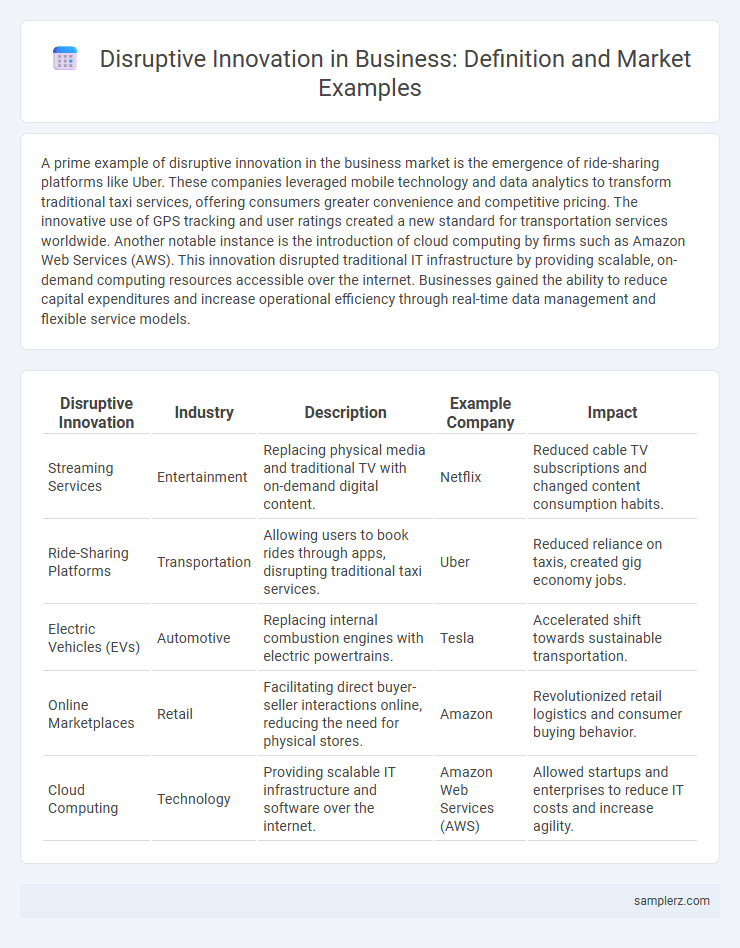A prime example of disruptive innovation in the business market is the emergence of ride-sharing platforms like Uber. These companies leveraged mobile technology and data analytics to transform traditional taxi services, offering consumers greater convenience and competitive pricing. The innovative use of GPS tracking and user ratings created a new standard for transportation services worldwide. Another notable instance is the introduction of cloud computing by firms such as Amazon Web Services (AWS). This innovation disrupted traditional IT infrastructure by providing scalable, on-demand computing resources accessible over the internet. Businesses gained the ability to reduce capital expenditures and increase operational efficiency through real-time data management and flexible service models.
Table of Comparison
| Disruptive Innovation | Industry | Description | Example Company | Impact |
|---|---|---|---|---|
| Streaming Services | Entertainment | Replacing physical media and traditional TV with on-demand digital content. | Netflix | Reduced cable TV subscriptions and changed content consumption habits. |
| Ride-Sharing Platforms | Transportation | Allowing users to book rides through apps, disrupting traditional taxi services. | Uber | Reduced reliance on taxis, created gig economy jobs. |
| Electric Vehicles (EVs) | Automotive | Replacing internal combustion engines with electric powertrains. | Tesla | Accelerated shift towards sustainable transportation. |
| Online Marketplaces | Retail | Facilitating direct buyer-seller interactions online, reducing the need for physical stores. | Amazon | Revolutionized retail logistics and consumer buying behavior. |
| Cloud Computing | Technology | Providing scalable IT infrastructure and software over the internet. | Amazon Web Services (AWS) | Allowed startups and enterprises to reduce IT costs and increase agility. |
Understanding Disruptive Innovation in Business
Disruptive innovation in business often involves introducing products or services that create new markets by targeting overlooked customer segments or simplifying complex offerings. A prime example is Netflix revolutionizing the entertainment industry by shifting from DVD rentals to streaming, effectively disrupting traditional cable television and video rental stores. This innovation leveraged digital technology and changing consumer preferences to establish a scalable and accessible platform, redefining media consumption patterns globally.
Key Characteristics of Disruptive Innovations
Disruptive innovations reshape markets by introducing simpler, more affordable products or services that initially target overlooked customer segments. Key characteristics include leveraging new technologies to create accessible solutions, gradually improving performance to meet mainstream needs, and undermining established competitors. Examples include Netflix, which transformed the entertainment industry by shifting from DVD rentals to streaming services, emphasizing convenience and on-demand access.
Classic Example: Netflix vs. Blockbuster
Netflix revolutionized the entertainment industry by introducing a subscription-based streaming service, enabling instant access to diverse content without late fees or store visits. Blockbuster, a dominant video rental chain, failed to adapt to this digital shift, leading to its rapid decline and bankruptcy. This classic example of disruptive innovation highlights how technology-driven business models can outperform traditional incumbents by meeting evolving consumer preferences.
Uber’s Transformation of Urban Transportation
Uber revolutionized urban transportation by introducing a disruptive innovation that replaced traditional taxi services with a convenient, app-based ride-hailing platform. Leveraging GPS technology and real-time data, Uber optimized route efficiency and expanded access to private rides, significantly reducing wait times for customers. The platform's scalable business model reshaped market dynamics, driving competition, and prompting regulatory changes across global cities.
Airbnb’s Impact on the Hospitality Industry
Airbnb revolutionized the hospitality industry by introducing a peer-to-peer lodging platform that disrupted traditional hotel business models. By leveraging digital technology and the sharing economy, Airbnb offered consumers flexible, affordable, and diverse accommodation options worldwide. This innovation forced established hotel chains to adapt their pricing strategies, enhance customer experiences, and embrace digital transformation to remain competitive.
The Rise of Digital Photography over Film
The rise of digital photography transformed the imaging market by replacing traditional film with instant image capture and digital storage, drastically reducing costs and processing time for consumers and professionals alike. Companies like Canon and Nikon shifted focus to digital cameras, while new entrants such as GoPro innovated with action and compact designs, fueling widespread adoption. This disruption not only reshaped consumer behavior but also dismantled the film industry's dominance, pushing giants like Kodak into bankruptcy and forcing a complete business model overhaul.
How Amazon Revolutionized Retail
Amazon transformed retail by pioneering e-commerce, leveraging advanced algorithms for personalized recommendations, and optimizing supply chain logistics with extensive warehousing and faster delivery systems. The introduction of Amazon Prime redefined customer expectations with benefits like expedited shipping and exclusive content, significantly increasing consumer loyalty. These innovations disrupted traditional brick-and-mortar models, forcing widespread adoption of digital sales platforms across the global retail industry.
FinTech Disruption: The Case of PayPal
PayPal revolutionized the payments industry by introducing a secure, user-friendly online platform that eliminated the need for traditional banking intermediaries, facilitating fast and convenient digital transactions globally. Utilizing innovative encryption technology and seamless integration with e-commerce sites, PayPal disrupted conventional financial services and accelerated the adoption of electronic payments. This breakthrough in FinTech lowered transaction costs, enhanced consumer trust, and reshaped the landscape of digital commerce worldwide.
Tesla and the Shift in Automotive Markets
Tesla revolutionized the automotive market by introducing electric vehicles with advanced autonomous driving capabilities and over-the-air software updates, disrupting traditional internal combustion engine manufacturers. The company's focus on sustainable energy solutions and high-performance electric cars accelerated the global shift toward electric mobility and reshaped consumer expectations. Tesla's innovative Gigafactories also streamlined battery production, reducing costs and setting new industry standards in scalability and efficiency.
Lessons Learned from Market Disruptors
Market disruptors like Uber revolutionized transportation by leveraging mobile technology to connect drivers and riders, creating a scalable and user-centric platform. Lessons learned emphasize the importance of understanding customer pain points, embracing technology to streamline processes, and challenging traditional business models to gain competitive advantage. Disruptive innovation requires agility, continuous feedback integration, and a willingness to redefine industry norms to achieve lasting market impact.

example of disruptive innovation in market Infographic
 samplerz.com
samplerz.com